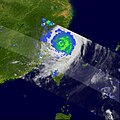Ficheiro:Saomai 2006-08-10 0558Z TRMM.jpg

Dimensões desta antevisão: 600 × 600 píxeis. Outras resoluções: 240 × 240 píxeis | 480 × 480 píxeis | 768 × 768 píxeis | 1 024 × 1 024 píxeis.
Imagem numa resolução maior (1 024 × 1 024 píxeis, tamanho: 727 kB, tipo MIME: image/jpeg)
Histórico do ficheiro
Clique uma data e hora para ver o ficheiro tal como ele se encontrava nessa altura.
| Data e hora | Miniatura | Dimensões | Utilizador | Comentário | |
|---|---|---|---|---|---|
| atual | 03h55min de 6 de setembro de 2006 |  | 1 024 × 1 024 (727 kB) | Coredesat | TRMM satellite image showing rainfall distribution within Typhoon Saomai as it makes landfall in Zhejiang, China. Image is from the [http://earthobservatory.nasa.gov/NaturalHazards/natural_hazards_v2.php3?img_id=13772 NASA Earth Observatory]. |
Utilização local do ficheiro
A seguinte página usa este ficheiro:
Utilização global do ficheiro
As seguintes wikis usam este ficheiro:
- de.wikipedia.org
- en.wikipedia.org

